By Greg Zyla —
Q: Greg, your automotive and auto nostalgia columns are what I look for every week in the Westerly Sun newspaper. I wonder if you could talk about Powel Crosley Jr., who I feel was one of the most famous industrialists ever and right up there with Henry J. Kaiser, of Kaiser-Frazer automobiles, and the noted WWII ship builder who you’ve written about before. When I was a kid, I had an uncle who owned a 1950 Crosley station wagon that had a Crosley radio in it. Thank you, Robert Jenkins, retired and living in Rhode Island.
A: Robert, I’d be happy to! I’ve written about Crosley and his cars before, but this time I’m going to mention many of the “other firsts” he’s been credited with both with his Crosley cars and the many other inventions and appliances he’s known for.
Let’s start this Crosley column with a bit of history.
Born Powel Crosley Jr. on Dec. 18, 1886 in Cincinnati, Ohio, he started Crosley Motors in 1939 as a subsidiary of his already large and successful Crosley Corporation. As a respected industrialist and entrepreneur, Crosley Jr. was responsible for many innovations in consumer products including small and large appliances, his famed radios, early TV broadcasting, and even airplane manufacturing.
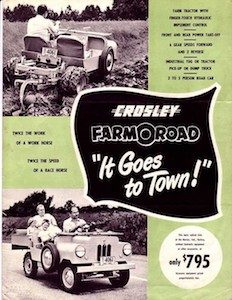
Crosley produced numerous vehicles, including this novel Farm-O-Road utility vehicle that went “twice as fast as a racehorse and did twice the work of a farm horse.” (Compliments Crosley Corporation)
The very first Crosley motorcar, his first real love, arrived in 1939 as a tiny, two-seater convertible that weighed just 925 pounds. Powered by a two-cylinder Waukesha design air-cooled engine that displaced 39 cu. in., the car could be parked in a consumer’s driveway starting at just $299. This first Crosley met with Crosley Jr. ‘s philosophy, “Every American who can afford a car should have an opportunity to buy a brand new, truly fine car.”
These first Crosley cars came in just three colors of yellow, gray or blue and they delivered 50-mpg fuel mileage. By 1942, Crosley expanded his offerings to include a panel truck, sedan, pickup and other styles. When World War II began, Crosley had sold nearly 6,000 cars and was the last American manufacturer to finally stop civilian car production ala the government mandate in 1942.
The government had Crosley concentrate on small military vehicles, radio transceivers, trailers, field kitchen units, gun turrets (gun bases / steeples) for boats and aircraft, and explosive proximity fuses during the war effort. Crosley vehicles included a small military “4×4 Pup”, which looked like an early Jeep design and powered by a two-cylinder engine. A go-kart style “Mule” was also produced for light military duty efforts.
When the war ended, Crosley resumed civilian car production and utilized larger four-cylinder water-cooled engines. Included were new models including a “Hotshot” sports car roadster featuring a front headlamp “bugeye” motif long before Austin Healey introduced its Bugeye Sprite in 1958.
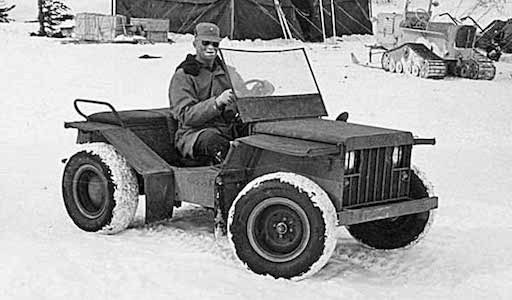
Crosley was heavily involved in military production, as this photo of a Crosley “Pup” was taken at Army Camp Hale, Colorado in 1943. The “Pup” was evaluated at the U.S. Army camp for freezing weather duty. (Photo and information compliments Crosley Corporation and Crosleyautoclub.com)
Although Crosley was phenomenally successful in everything he did, his cars never really caught on with the post-war consumer. By then America was in a “bigger is better” buying mood and the “Big Three” of GM, Ford and Chrysler cashed in on the frenzy. The 1950 Crosley Wagon your uncle owned came closest to being an actual compact size car, yet was still built on the smaller, 80-inch wheelbase, Crosley platform. Popular was the Crosley Farm-O-Road, a small farm vehicle that was legal to drive on the highway and promoted as “twice the work of a farm horse and twice the speed of a racehorse.”
Crosley’s “small car” principles would later prove successful, but not for Crosley Jr. himself. As the 1950-decade went on, many American and foreign small cars appeared on our nation’s highways and by 1960, they were all over the place. Here in 2024, most every major manufacturer worldwide produces a subcompact vehicle that is popular with buyers of all ages.
Notable are some of Crosley’s industry firsts: the push-button radio, early television productions (including soap operas), first refrigerator with shelves in the door, most powerful commercial radio station ever (WLW Cincinnati), complete lighting for the first baseball night game in 1935 at Crosley Field (Reds versus Phillies), first to use disc brakes on American cars, first to use the term Sport Utility, first overhead cam engine in 1946, and first post-war sports car, the 1949 Hotshot.
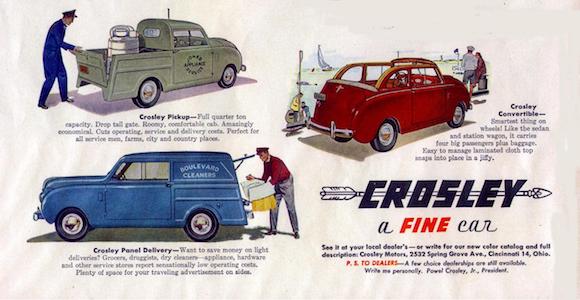
A full line 1948 auto and truck ad featured numerous models that Crosley produced. Although sub-compact and even smaller by today’s standards, most Crosley vehicles rode on an 80-inch wheelbase, while the Hotshot sports car rode on an 85-inch wheelbase. (Compliments Crosley Corporation)
Although not the first, Crosley also produced washing machines, stoves, ovens, air conditioners, televisions, kitchen cabinets, record players, toasters, blenders, and other small kitchen appliances. Crosley kitchen appliances and radios are still available to this day, including a nice retro AM/FM Radio with the original Crosley logo. (See www.crosley.com.)
Now, let’s talk about baseball.
Known for his love of the game, Crosley purchased the financially downtrodden Cincinnati Reds franchise in 1934 and his ownership brought immediate stability and innovation to the team. The Reds played their home games at Crosley Field, originally known as Redland Field, prior to renaming. Known for a sloped terrace in left field, Babe Ruth stumbled and fell on the Crosley Field slope, as did Willie Mays, who also took an actual tumble.
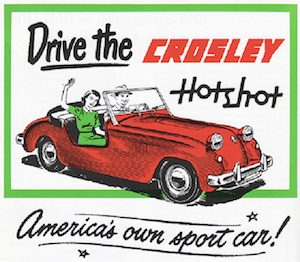
America’s first post war sports car was the 1949 Crosley Hotshot, featuring looks like the 1958 Austin Healey BugEye Sprite. (Compliments Crosley Corporation)
The ballpark stood at the corner of Western Avenue and Findlay Street in Cincinnati’s West End. The Reds’ last game at Crosley Field took place June 24, 1970 against the San Francisco Giants. On April 19, 1972, after being used as a parking complex, Pete Rose pulled a lever that sent a wrecking ball into the former Crosley Field and began its final demolition.
The current Cincinnati Reds ballpark, built in 2003, is called “Great American Ballpark” that features a street-level main entrance named “Crosley Terrace” in honor of Crosley Jr.
In summary, I agree with you Robert that Powel Crosley Jr. deserves a top spot when discussing the most successful American industrialists and entrepreneurs. From radios to cars to baseball, he forever etched his name in the annals of American inventiveness and was a true industrial genius. His Crosley vehicles totaled nearly 77,000 sold when he ceased production in mid-1952.
Crosley passed away at age 74 in 1961, just as his beloved Reds were slowly transforming into what would become “The Big Red Machine” and dominate baseball throughout the 1970 decade.
(Greg Zyla is a syndicated auto columnist who welcomes reader interaction on auto nostalgia, collector cars and motorsports at greg@gregzyla.com or extramile_2000@yahoo.com.)

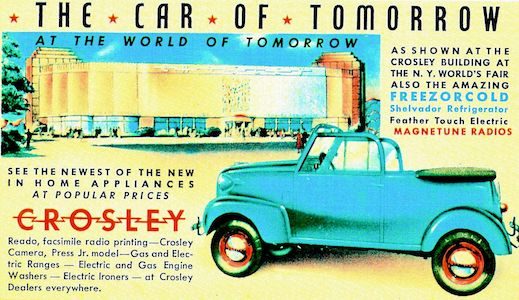
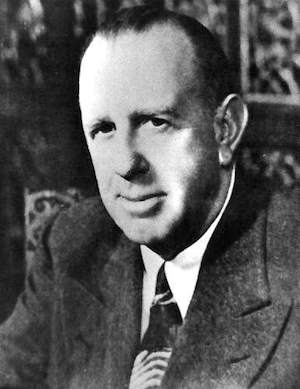

Be the first to comment on "Collector Car Corner / Cars We Remember; Powel Crosley Jr.; from radios to cars to baseball and everything in between"